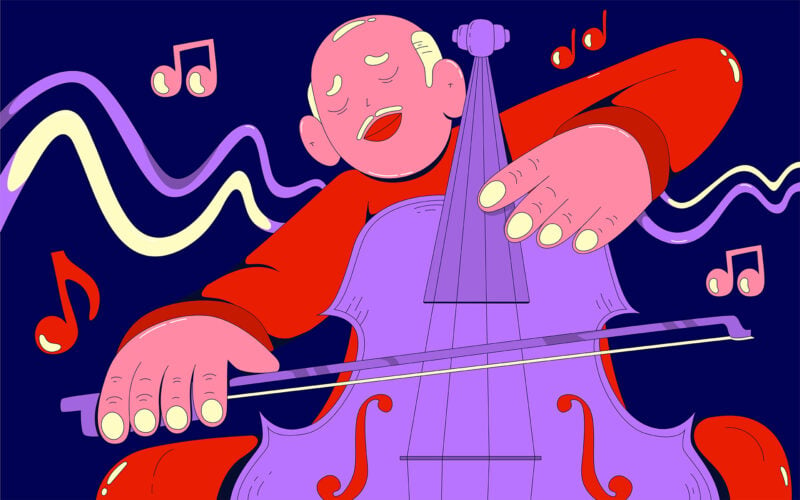Illustration: Daniel Batista
Also known as the violoncello, this stringed instrument and its warm tones can be found all across the musical landscape.
Rising to prominence during the Baroque era of the 17th and 18th centuries, the cello has since become essential to countless works of classical music and even left its mark on modern movements like rock and jazz. In this article, let’s dive into the rich history and lasting influence of this classic yet versatile instrument.
The history of the cello
Along with the viola and double bass, the cello (separate from the similar-looking viola da gamba) is part of the aptly-named violin family of stringed instruments that began their development during the 1500s in Italy.
Strings started combining metal wire with animal gut in the mid-1600s, which meant that instruments could be smaller than before while also producing a cleaner sound. This is what led luthiers (makers of stringed instruments) to create the first cellos. However, modern cellos are even more updated versions of their Baroque-era counterparts, with longer necks (allowing you to play higher notes), tenser strings, different bow designs, and a metal endpin.
By the 18th century, the instrument’s popularity had spread north of Italy to the rest of Europe, and it became an important element of small chamber ensembles and massive symphony orchestras. Arguably the most famous and recognizable works of solo cello music, the Six Suites for Cello were composed during this period by Johann Sebastian Bach. These suites have since inspired countless people (including me as a child) to start learning how to play the cello, especially after hearing the legendary Yo-Yo Ma perform its opening movement.
The cello remains an essential part of classical and avant-garde music to this day, with the 20th century explosion of popular music bringing it into jazz, rock, disco, hip hop, and more.
How does the cello work?
The cello is considered a chordophone, a type of instrument that generates sound from strings that vibrate when played by a performer. Other instruments in this same category include the violin, viola, and upright bass, as well as guitars, lutes, banjos, sitars, and even the harpsichord. Most chordophones are also designed so that the vibrating strings also vibrate the rest of the instrument, which is often hollow. This helps amplify the sound so that it’s easier to hear.

The different components that make up a cello
A cello consists of four tuned strings (usually made of metal) stretched across a mostly wooden construction. The carved scroll at the top contains pegs for tuning the strings, which follow the neck and the fingerboard all the way down past the raised bridge to the tailpiece and end pin, which helps anchor the instrument to the floor. The cello’s main body is hollow and features two openings called F holes that help bring those internal vibrations created by the strings outwards and towards the audience (but electric cellos without a hollow body are a thing too).
Cello bows are also mostly composed of wood, with horsehair or synthetic hair drawn across and tightened to make contact with the strings. The cellist can control the tightness of the bow hairs, and also applies pine rosin directly to these hairs so they make better contact with the strings.
How is the cello played?
The cello is played seated, with the right hand either directly plucking the strings or drawing a bow across them to produce sound. The left hand is used to press strings down against the fingerboard to create specific pitches—unlike a guitar there are no frets, so getting the right note is all about practice. We could easily dedicate a separate article to just cello technique; there are that many different ways to pluck, bow, and interact with these four simple strings!
What does the cello sound like?
A basic entry-level cello can be acquired for a few hundred dollars, while more high-quality instruments can easily run into the tens of thousands (and way, way beyond).
Aside from being featured in dozens of sonatas and concertos by legendary composers as well as countless film scores, the cello’s signature sound is all over pop music too—you’ve likely heard it without even realizing it! Here are some personal picks from across the spectrum:
- “Cello Concerto No. 1 in A Minor” (Camille Saint-Saëns, 1872)
- “Élégie Op. 24” (Gabriel Fauré, 1880)
- “Cello Sonata Op. 25” (Paul Hindemith, 1922)
- “Eleanor Rigby” (The Beatles, 1966)
- “Something in the Way” (Nirvana, 1993)
- “Yearning Of The Sword” from the Crouching Tiger, Hidden Dragon OST (Tan Dun, 2000)
- “Why So Serious?” from The Dark Knight OST (Hans Zimmer, 2008)
How to incorporate the cello’s sound into your own music
If you’re itching to get some cello into your own productions but don’t have one that you can record, here’s a curated Collection of cello samples from Splice Sounds, in addition to even more packs below that range from classical to experimental:
- Cello Distortions
- Cello Explorations with Hadas Kleinman
- Iconic Melodies – The Classics
- Elegant Strings
What’s your favorite piece of music featuring the cello? Start a conversation with other musicians via our Discord.
Incorporate the cello’s versatile sound into your own music:
May 19, 2022



